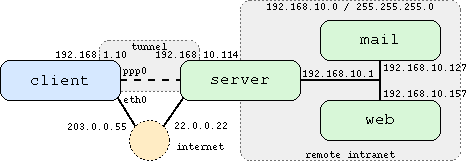Routing HOWTO
Internal Address of a PPTP Server
A PPTP Server can have multiple IP addresses and interfaces. When we said the internal address, we mean the IP address for the interface on the far side of the server with respect to the client.
For example, consider this diagram.

The diagram shows that the server has the following IP addresses:
- 22.0.0.22 the external public address used to reach the server
from the client to establish a tunnel,
- 192.168.10.114 the remote IP address of the client's tunnel,
allocated once the tunnel is established, (as more clients connect,
more of these addresses are allocated),
- 192.168.10.1 the internal IP address connected to the rest of the network that client is to reach once the tunnel is established.
However
When a PPTP server is used as an access server for an internet service provider (as is the case with many ADSL services), the internal address is the address that faces the internet, so the word internal is inadequate.
Can't Find It?
If you cannot find the internal address, use any address you like, provided it isn't one already used on any of your current interfaces, and you expect to have to use the tunnel to reach it.
Denis Vlasenko wrote:
Date: Fri, 30 May 2003 09:02:58 +0300 To: James Cameron Cc: pptpclient-devel at lists.sourceforge.net From: Denis Vlasenko Subject: Re: [pptp-devel] Re: Connection dying [...]Actually I think now that any address can be set as peer IP, because the link is actually point-to-point. What will happen if I assign arbitrary IP B to the remote end after pppN is up? I will have a host route 'go thru pppN if you want to reach B'. I will have to set up routes like 'if you want to reach network N, route your packets via IP address B (and hence, send them over pppN)' for each network which is to be reachable through tunnel. And this will work even if remote side haven't a faintest idea what is address B, because packets destined to network N do not have address B in their headers.
|
If you can find it, the internal address is probably more correct, as it would ease understanding of anyone else trying to understand what you did later.